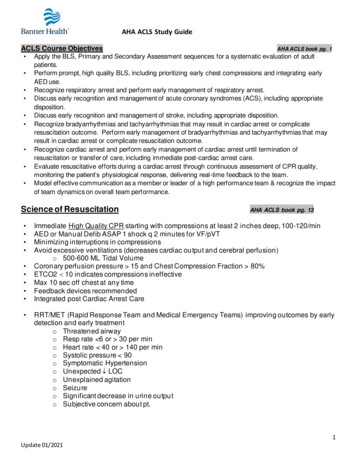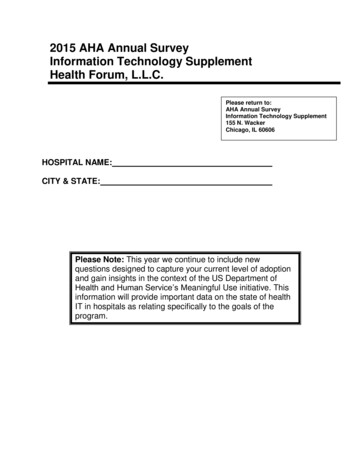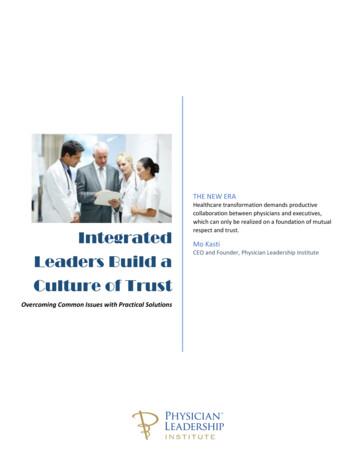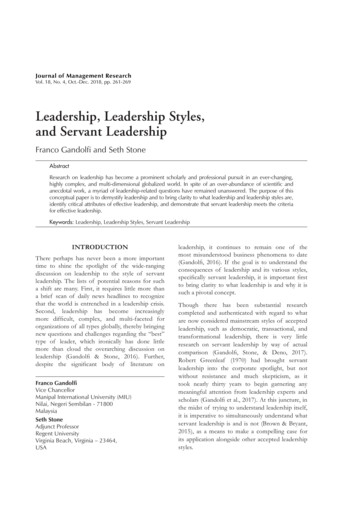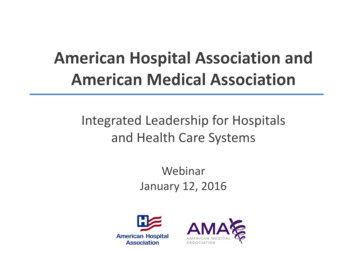
Transcription
American Hospital Association andAmerican Medical AssociationIntegrated Leadership for Hospitalsand Health Care SystemsWebinarJanuary 12, 2016
Integrated Leadership Collaborative discussions betweenAHA and AMA Opportunity to redefine care deliveryto achieve the Triple Aim through newcare and payment models Many organizational models aresuccessful, but essential to those is astructure with collaborative andintegrated leadership betweenphysicians and hospital
History of the AHA ‐ AMA Integrated Leadershipfor Hospitals and Health Systems programAMA ‐ AHAJointLeadershipConference onNew Modelsof CareOctober 2013Proceedingsfrom the JointLeadershipConferencepublishedHealth AffairsBlog postpublishedDevelopmentbegins on theAHA ‐ AMAPrinciples ofIntegratedLeadership forHospitals andHealthSystemsApril 2014April 20142014AMA ‐ AHAExpanding October 2014AHA ‐ AMAPrinciples ofIntegratedLeadership forHospitals andHealthSystemspublishedJune 2015
What is successful integrated leadership? Requires functional partnership between organized physiciansand hospital Requires capability to accept and manage clinical and financialrisk, improve quality and reduce cost Management decisions on quality improvement andpopulation health agenda should be made jointly betweenphysicians and hospital
Principles for Integrated Leadership1.Physician and hospital leaders with:––––––––shared vision and missionsimilar values and expectationsaligned financial and non‐financial incentivesgoals aligned across the board with appropriate metricsshared responsibility for financial, cost, and quality targetsservice line teams with accountabilityshared strategic planning and managementshared focus on engaging patients as partners in their care2.An interdisciplinary structure that supports collaboration in decision‐making, preserving clinical autonomy (defined as putting the needs ofthe patient first) needed for quality patient care while working withothers to deliver effective, efficient and appropriate care.3.Integrated leadership at all levels and participation in key managementdecisions.– Teams of clinicians and administrators leading together at every level– Teams accountable to and for each other and can commit for each other
Principles for Integrated Leadership4. A collaborative, participatory partnership built on trust.– Sense of interdependence and working toward mutual achievement of theTriple Aim– Physicians and hospital leadership must trust in each other’s good faith andabilities5. Open and transparent sharing of clinical and business information by allparties across the continuum of care.6. Clinical information system infrastructure that allows capture andreporting of key clinical quality and efficiency performance data andaccountability across the system to those measures.
Leadership skillsBoth physician and hospital leaders must possess the knowledge, skills andprofessional attitudes to be effective leaders and managers in empowerment‐oriented,and consensus‐based management models.Physician leader skills Mission and strategy development,alignment and deploymentUnderstanding of patient and consumerexpectationsQuality measurement and improvementTeam building, negotiation andmanagementEffective adoption of health care clinicalinformation technologyRisk, finance and cost management invarious types of practice organizationsUnderstanding payment based on care,quality, outcomes and accountabilityPopulation health managementHospital leader skills Understand medical professionalism, caredelivery processes and clinical decisionmaking Knowledge of physician practice financesand workflow Ability to achieve consensus with physicians Understand need for physicians to advocatefor patients Accept need for physician clinical decisionautonomy in specific settings whileexpecting physician accountability foroverall institutional success Willingness to create true integratedleadership model by sharing managementresponsibilities and accountabilities
Key elements for physician organizations Inclusive governance process overseeing competencies in qualitymanagement, practice efficiency, clinical discipline, clinical and financialrisk management Process for leadership selection, support, and training Structures outlining membership requirements, including professionalconduct, clinical protocols Development and review of physician organization’s overall strategy andguidelines for employment or affiliation arrangements Adopting clinical information technology and resources necessary foreffective population and patient care management Robust member communication strategy and plan
Cultural needs A focus on health of entire population served by integrated health system Common mission, vision and values Mutual understanding and respect despite different training and perspectives Sense of common “ownership” of integrated health system and its reputation Joint commitment to performance measurement and improvement Focus on individual patient’s care over time and across the continuum Performance data that is understandable, timely and trusted Fair financial and non‐financial incentives aligned to improve care and managecosts across the organization Shared governance and involvement in decision making A sense of responsibility for the integrated health system Consensus decision making between all parties
Challenges to success Commitment to business model transformation Differing mind sets Lack of clarity on values Lack of more “accessible” and generalizable models of physician organization Lack of integrated leadership and management skills Need for robust of primary care involvement Need for payer partnering and new payment models Legal and regulatory issues Contractual issues Ancillary services issues Coordination of the Organized Medical Staff
Expanding the Collaboration
Questions/Discussion
Integrated Leadership for Hospitals and Health Systems AMA ‐AHA Expanding the Physician‐ Hospital Integrated Leadership meeting AHA ‐AMA Principles of Integrated Leadership for Hospitals and Health Systems published October 2013 April 2014 April 2014 2014 October 2014 June 2015
